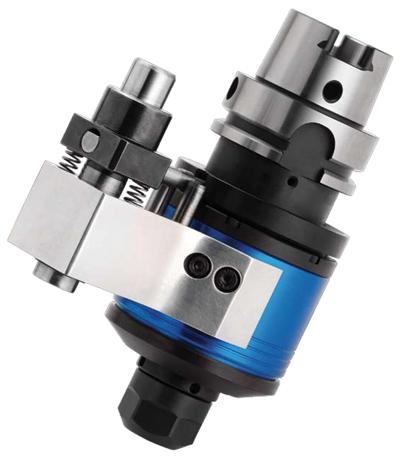
BENZ offers high-speed spindle speeders for the wood, metal and composites industries.
"BENZ high-speed spindles provide solutions for all applications where the existing machine's rpms and the resulting cutting speeds do not allow for efficient production," explained John Roasa, National Sales Manager of the metal division at BENZ Inc. "The addition of BENZ high-performance spindle speeders increases the rpms on standard machine tool machining center spindles, boosting both output and productivity."
Primarily designed for high-speed drilling, BENZ high-speed spindles are also suitable for precise machining and slight millworking without any specific surface hardness. They offer increased surface finish and milling capabilities and are capable of running ceramic end mills.
BENZ offers high-speed spindles in two different variations, Type SL and Type SLI. Type SL is available with jacket cooling, which reduces operating temperature and results in consistent operating parameters. Type SLI, equipped with an internal coolant system and a jacket cooling system, increases in-use speeds by thousands, with a 1:5 ratio, and is designed for tools with a cooling channel and an internal coolant supply. Those equipped with coolant can operate at up to 40,000 rpms and coolant pressure up to 80 bar, while those without coolant can run at up to 18,000 rpms.
All BENZ high-speed spindles are self-cooling and engineered for an unlimited duty cycle. They also deliver improved stability and less vibration, with optimized temperature and weight. An exchangeable torque arm holds the spindle in position and avoids twisting, which makes BENZ high-speed spindles highly flexible. Their tools can be changed automatically with a Stop Block machine tool changer, or manually by installing a block or pin to keep the torque arm from rotating.
Contact Details
Related Glossary Terms
- composites
composites
Materials composed of different elements, with one element normally embedded in another, held together by a compatible binder.
- coolant
coolant
Fluid that reduces temperature buildup at the tool/workpiece interface during machining. Normally takes the form of a liquid such as soluble or chemical mixtures (semisynthetic, synthetic) but can be pressurized air or other gas. Because of water’s ability to absorb great quantities of heat, it is widely used as a coolant and vehicle for various cutting compounds, with the water-to-compound ratio varying with the machining task. See cutting fluid; semisynthetic cutting fluid; soluble-oil cutting fluid; synthetic cutting fluid.
- gang cutting ( milling)
gang cutting ( milling)
Machining with several cutters mounted on a single arbor, generally for simultaneous cutting.
- hardness
hardness
Hardness is a measure of the resistance of a material to surface indentation or abrasion. There is no absolute scale for hardness. In order to express hardness quantitatively, each type of test has its own scale, which defines hardness. Indentation hardness obtained through static methods is measured by Brinell, Rockwell, Vickers and Knoop tests. Hardness without indentation is measured by a dynamic method, known as the Scleroscope test.
- machining center
machining center
CNC machine tool capable of drilling, reaming, tapping, milling and boring. Normally comes with an automatic toolchanger. See automatic toolchanger.
- milling
milling
Machining operation in which metal or other material is removed by applying power to a rotating cutter. In vertical milling, the cutting tool is mounted vertically on the spindle. In horizontal milling, the cutting tool is mounted horizontally, either directly on the spindle or on an arbor. Horizontal milling is further broken down into conventional milling, where the cutter rotates opposite the direction of feed, or “up” into the workpiece; and climb milling, where the cutter rotates in the direction of feed, or “down” into the workpiece. Milling operations include plane or surface milling, endmilling, facemilling, angle milling, form milling and profiling.







